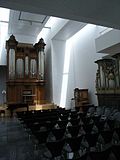Organ Art Museum
The Organ Art Museum in Windesheim in the Bad Kreuznach district is a musical instrument museum . The founding director of the Orgel Art Museum is Wolfgang Oberlinger .
The museum displays over 30 keyboard instruments on 900 m², including organ instruments , clavichords , artificial harmoniums and table pianos . In addition to historical instruments, replicas and contemporary instruments can be found here.
history
The museum building was designed by the Oberlinger Architects on behalf of the Bad Kreuznach district and opened in 2001. Until 2017, the museum was operated by the Bad Kreuznach district. The operator has been a development association since 2018, at which time the building was also transferred from the public sector to a private foundation.
On August 20, 2019, the 50-euro gold coin with the motif of a fortepiano was presented to the public by Julia Klöckner as the representative of the federal government.
Instrument inventory
Four smaller organs from the 18th century are exhibited in the museum, a work by the Stumm and Bürgy families ( Johann Georg Bürgy and Philipp Heinrich Bürgy ) as well as two Italian organs. Another eight organ instruments are newly built by the Oberlinger company, four of which are replicas of small historical instruments (Gothic organ, shelf , positive , claviorganum ). Another three newer small organs come from the Otto Heuss collection .
Another focus of the museum is a collection of historical piano instruments (8) and clavichords (2). The pianos include one each by Érard (1870) and Broadwood (1825). Modern keyboard instrument making is represented by a harpsichord from Neupert, a virginal from Sassmann, a piano from Sauter (1996) and Schimmel (design Luigi Colani ).
Exhibits (selection)
| year | instrument | builder | image | Remarks |
|---|---|---|---|---|
| 18th century | Italian organ | unknown builder | 8 registers on one manual without pedal, short octave | |
| 18th century | organ | Mute | 6 stops on one manual, attached pedal | |
| 1779 | Italian organ | Pietro Pirani | 10 stops, attached pedal (CDEFGA – e) | |
| 1780 | Fortepiano | Johann Conrad Bürgy | the only surviving Bürgy fortepiano | |
| 1802 | organ | Johann Georg Bürgy and Philipp Heinrich Bürgy | 13 stops on a manual and pedal, originally for Büdingen, Lutheran Church; largely preserved | |
| around 1817 | wing | Johann Erhard Schiedmayer | with two toggle levers (felt strips for damping and damping cancellation) | |
| around 1825 | wing | John Broadwood & Sons | ||
| around 1850 | Square piano | Carl Mand | a pedal to cancel the damping | |
| 1859 | Physharmonica | Philipp J. Trayser & Cie. (Stuttgart) | with expression, forte divided into bass / treble | |
| 1988 | Claviorganum | Gebr. Oberlinger (organ part), Martin Sassmann (harpsichord part) | Copy of an original from a Scottish private collection (1745); two-manual: organ with 5 stops on I and harpsichord on I and II | |
| 2001 | organ | Gebr. Oberlinger |

|
Concert organ with 19 registers on two manuals and pedal, 3rd manual prepared for expansion; in the style of Aristide Cavaillé-Coll |
Web links
- Verbandsgemeinde Langenlonsheim: Organ Art Museum
- oberlinger.eu: Presentation of the instruments
Individual evidence
- ↑ oberlinger.eu: exhibits , accessed on November 17, 2014.
- ↑ Stephen Weber: Orgel-Art-Museum Windesheim - the gift of millions. In: Allgemeine Zeitung. VRM GmbH & Co. KG, November 24, 2017, accessed on November 24, 2017 .
- ↑ Stephen Weber: Windesheimer Organ Art Museum is suddenly a cultural heritage. In: Allgemeine Zeitung. VRM GmbH & Co. KG, accessed on October 29, 2018 .
- ↑ Roland Eberlein : New Reconstructions of Medieval Organs (PDF file; 792 kB), accessed on November 17, 2014.
- ^ Italian organ , accessed November 17, 2014.
- ↑ Stumm-Orgel , accessed on November 17, 2014.
- ↑ Pirani organ , accessed on November 17, 2014.
- ^ Bürgy-Fortepiano , accessed on November 17, 2014.
- ^ Bürgy organ , accessed on November 17, 2014.
- ^ Schiedmayer wing , accessed on November 17, 2014.
- ↑ Broadwood Grand , accessed November 17, 2014.
- ^ Mand-square piano , accessed on November 17, 2014.
- ↑ Physharmonika , accessed on November 17, 2014.
- ^ Claviorganum , accessed November 17, 2014.
- ↑ Concert organ , accessed on November 17, 2014.
Coordinates: 49 ° 54 ′ 40.3 " N , 7 ° 49 ′ 9.8" E
